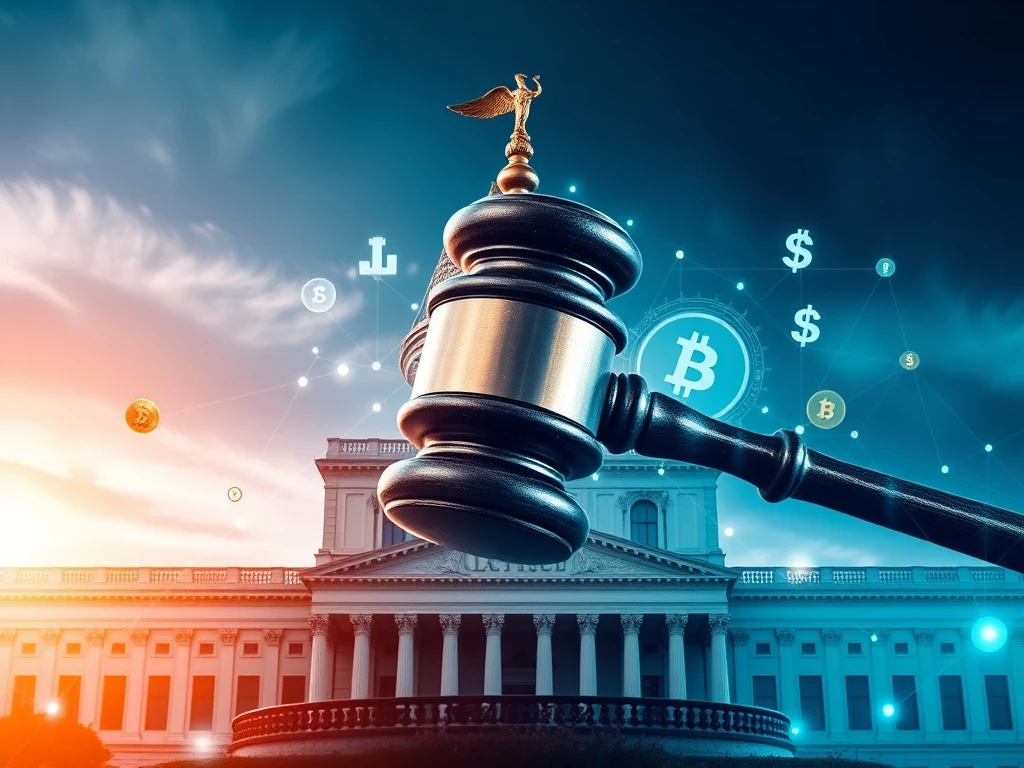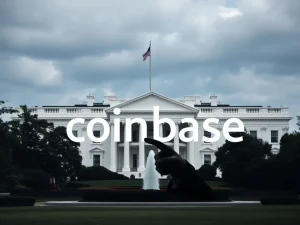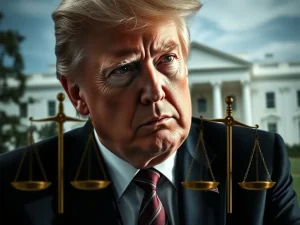Unlocking Crypto’s Future: Senate Pivots to Market Structure After Landmark Stablecoin Bill

The United States Congress is buzzing with activity concerning the future of digital assets. After a significant move with the passage of a landmark stablecoin bill, the focus is now rapidly shifting towards establishing a comprehensive framework for the broader crypto market structure. This pivot signals a critical phase in US crypto regulation, aiming to bring clarity and stability to an industry that has long sought clear legislative guidance.
Decoding US Crypto Regulation Efforts: What’s Driving the Legislative Push?
For years, the cryptocurrency industry has called for clear regulatory guidelines in the United States. Recent legislative actions indicate that lawmakers are finally heeding this call. The journey towards comprehensive US crypto regulation is complex, involving multiple committees and chambers, each working on different aspects of digital asset oversight. This concerted effort highlights a growing recognition of cryptocurrencies’ importance in the global financial landscape. While progress is being made, the path to a unified regulatory framework is fraught with political and practical challenges. Understanding these efforts is key for anyone involved in the digital asset space.
The Landmark Stablecoin Bill’s Journey: A Path to Clarity?
A major legislative milestone was recently achieved with the US Senate’s passage of the GENIUS Act, a significant stablecoin bill. This bipartisan effort, approved by a 68-30 vote on June 17, aims to regulate payment stablecoins, addressing concerns about systemic risk and consumer protection. The bill has now moved to the House of Representatives, where it awaits further discussion, potential amendments, and a possible floor vote. This development marks a crucial step towards integrating digital currencies into the traditional financial system, providing a foundation for future legislative endeavors. The swift passage of this stablecoin bill demonstrates a growing legislative appetite for crypto-specific frameworks.
Shaping the Digital Assets Market Structure: What’s on the Senate’s Agenda?
With the stablecoin bill progressing, the Senate is now turning its attention to the broader digital assets market structure. On Tuesday, the Senate Banking Committee’s digital asset subcommittee will hold a pivotal hearing. This session is part of a bipartisan push to establish legislative frameworks for digital asset markets. Testimonies are expected from key figures in the crypto and academic sectors, including Ryan VanGrack, Vice President of Legal at Coinbase; Greg Xethalis, General Counsel at Multicoin Capital; and Sarah Hammer, Executive Director at the University of Pennsylvania Wharton School. The insights from these experts will be crucial in shaping future legislation, aiming to create a clearer, more predictable environment for crypto businesses and investors.
Key Testimonies Expected at the Senate Hearing:
- Ryan VanGrack (Coinbase): Representing a major crypto exchange, offering insights on operational challenges and regulatory needs.
- Greg Xethalis (Multicoin Capital): Providing perspective from the investment side, focusing on market efficiency and innovation.
- Sarah Hammer (Wharton School): Offering an academic and economic viewpoint on the implications of market structure frameworks.
What’s Next for Digital Assets Legislation?
While the US Senate considers its approach, the House of Representatives is already advancing its own legislation regarding digital assets. Earlier this month, the House Agriculture Committee and the House Financial Services Committee voted to advance the Digital Asset Market Clarity, or CLARITY Act. This bill is expected to head for a floor vote soon. It remains uncertain whether the Senate will introduce its own version of the CLARITY Act as a companion bill or incorporate aspects of the House bill into its legislative efforts. The coordination, or lack thereof, between the two chambers will significantly influence the speed and nature of future crypto legislation, directly impacting the entire digital assets ecosystem.
Navigating the Complexities of US Senate Action: Political Hurdles Ahead?
Despite the bipartisan progress on stablecoins and the ongoing discussions on market structure, significant political challenges persist. Many Democrats in Congress express concerns about potential personal profit for US President Donald Trump and his family, given their reported ties to the crypto industry through memecoins, the World Liberty Financial platform, and political donations from digital asset companies’ executives. President Trump has indicated he would sign the GENIUS Act quickly if it passes the House. However, it is unclear if digital assets will remain a top priority for the president amidst other pressing national and international issues. These political considerations add layers of complexity to the legislative process, making the outcome of these bills less predictable and adding a layer of uncertainty to the US Senate’s ongoing work.
Challenges and Considerations:
- Political Pushback: Concerns over potential conflicts of interest and partisan divides.
- Inter-Chamber Coordination: Aligning House and Senate efforts for cohesive legislation.
- Presidential Priorities: The extent to which digital assets will remain a focus for the executive branch.
In conclusion, the US legislative landscape for cryptocurrencies is undergoing a significant transformation. The passage of the stablecoin bill and the subsequent shift to establishing a comprehensive market structure framework represent crucial steps towards regulatory clarity. While challenges remain, the ongoing bipartisan efforts in both the Senate and the House signal a serious commitment to integrating digital assets into the mainstream financial system. The coming months will be pivotal in determining the final shape of US crypto regulation, impacting investors, businesses, and the broader digital economy. Stay informed as these legislative developments unfold, shaping the future of digital finance.








